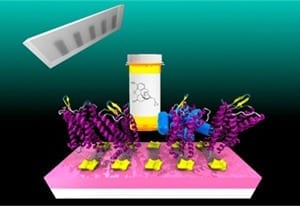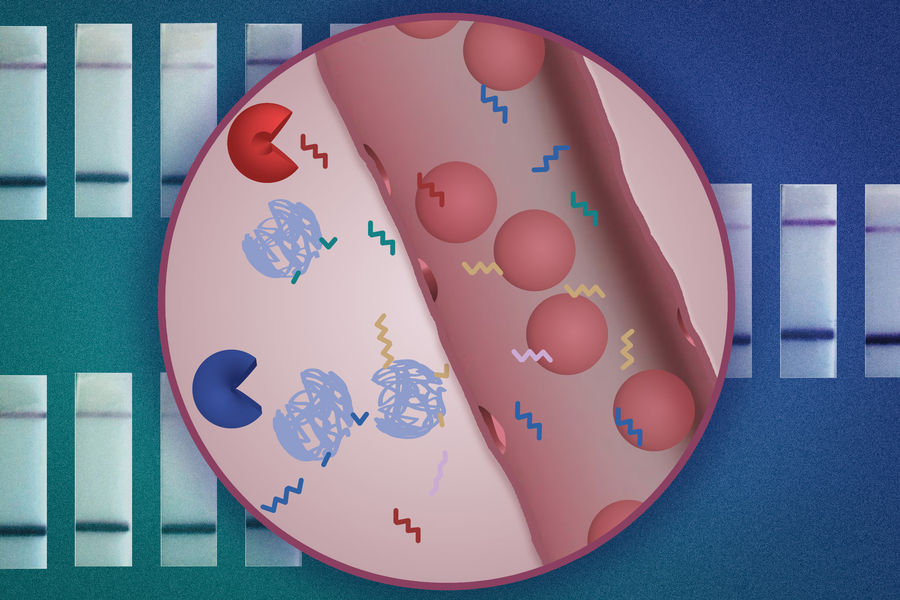
Researchers have shown a way to mass-produce devices that could be useful in drug development and a variety of diagnostic tests
Almost every biological process involves sensing the presence of a certain chemical. Finely tuned over millions of years of evolution, the body’s different receptors are shaped to accept certain target chemicals. When they bind, the receptors tell their host cells to produce nerve impulses, regulate metabolism, defend the body against invaders, or myriad other actions depending on the cell, receptor, and chemical type.
Now, Univ. of Penn researchers created an artificial chemical sensor based on one of the human body’s most important receptors—one that is critical in the action of painkillers and anesthetics. In these devices, the receptors’ activation produces an electrical response rather than a biochemical one, allowing that response to be read out by a computer.
By attaching a modified version of this mu-opioid receptor to strips of graphene, researchers have shown a way to mass-produce devices that could be useful in drug development and a variety of diagnostic tests.
Their study combines recent advances from several disciplines and labs around campus, including those of A.T. Charlie Johnson, director of Penn’s Nano/Bio Interface Center and professor of physics in Penn Arts & Sciences, Renyu Liu, assistant professor of anesthesiology in the Perelman School of Medicine, and Jeffery Saven, professor of chemistry in Penn Arts & Sciences.
Saven’s and Liu’s groups have used computational techniques to redesign the mu-opioid receptor to make it easier to use in research. In its natural state, the receptor is not water soluble, making many common experimental techniques impossible. Worse, proteins like this receptor would normally be grown en masse using genetically engineered bacteria, but parts of the natural mu-opioid receptor are toxic to the E. coli used in this method.
After Saven and Liu addressed these problems with the redesigned receptor, they saw that it might be useful to Johnson, who had previously published a study on attaching a similar receptor protein to carbon nanotubes. In that case, the protein was difficult to grow genetically, and needed to include additional biological structures from the receptors’ natural membranes in order to remain stable.
Saven and Liu’s computationally redesigned protein, however, could be readily grown and attached directly to graphene, opening up the possibility of mass-producing biosensor devices that utilize these receptors.
The Latest on: Cyborg sensor
[google_news title=”” keyword=”Cyborg sensor” num_posts=”10″ blurb_length=”0″ show_thumb=”left”]
via Google News
The Latest on: Cyborg sensor
- Cyborg Cockroaches With Micro-Computers On Their Backs Skillfully Avoid Obstacleson April 20, 2024 at 5:25 am
Hirotaka Sato turned Madagascar hissing cockroaches into cyborgs by placing microcomputers on their backs to remotely control movement.
- Army of Backpack-Wearing Cyborg Cockroaches Swarm Desert Targeton April 16, 2024 at 3:41 pm
Researchers at Nanyang Technological University in Singapore have unleashed an army of remote-controlled cyborg cockroaches ... by a larger robot to take sensor readings, hunt down specific ...
- Army of Backpack-Wearing Cyborg Cockroaches Swarm Desert Targeton April 15, 2024 at 5:00 pm
Researchers at Nanyang Technological University in Singapore have unleashed an army of remote-controlled cyborg cockroaches to swarm a target ... eventually be deployed by a larger robot to take ...
- Watch a swarm of cyborg cockroaches controlled by computerson April 15, 2024 at 5:00 pm
A swarm of remote-controlled cyborg cockroaches can navigate to a ... would take too long for a single machine, such as taking sensor readings or hunting for specific objects.
- UFC 300: Cris Cyborg to help Holly Holm prepare for Kayla Harrison fighton February 8, 2024 at 3:59 pm
Cyborg and Holm are former opponents, with Cyborg defending her UFC featherweight title in 2017 Bellator featherweight champion Cris Cyborg says she intends to help Holly Holm prepare for her ...
- Cyborg pianist: Transforming classical music with AI and brain dataon November 12, 2023 at 7:38 pm
Zubin Kanga describes himself as a pianist, composer and technologist. In his latest work, Cyborg Pianist, which premiered at Kings Place, London, he commissioned composers to create new works ...
- Cyborg 009: Call of Justice Vol. 1on September 8, 2023 at 3:53 am
Best Movies of 2024: Best New Movies to Watch Now Link to Best Movies of 2024: Best New Movies to Watch Now 25 Most Popular TV Shows Right Now: What to Watch on Streaming Link to 25 Most Popular ...
via Bing News










